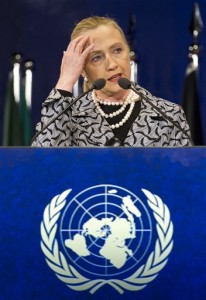Can We Get More Progress On Short-Lived Climate Pollutants After Rio?
 Despite the flop in the official negotiations, Rio+20 stimulated many new commitments and reinvigorated international conversations about how to redirect growth in a more sustainable manner.
Despite the flop in the official negotiations, Rio+20 stimulated many new commitments and reinvigorated international conversations about how to redirect growth in a more sustainable manner.Governments, business leaders, and civil society demonstrated new models for innovative partnerships for addressing sustainable development and emphasized alternative approaches to solving global threat of climate change. The Climate and Clean Air Coalition is an excellent example of such an approach.
The Climate and Clean Air Coalition brings together partners to apply already-existing solutions to cut short-lived climate pollutants that will cut in half the rate of global warming in the near-term. Short-lived climate pollutants (SLCPs) — such as black carbon, soot, methane, hydrofluorocarbons (HFCs), and tropospheric ozone — are shorter lived than carbon dioxide, but much more potent and account for around one-third of global warming. Some of these potent greenhouse gases are deadly: Each year millions of people die prematurely and more are diagnosed from a high incidence of dangerous respiratory disease. They also accelerate melting of the Arctic and are responsible for extensive crop losses each year.
US Environmental Protection Agency Administrator Lisa P. Jackson provided an update on the CCAC during the Rio conference as an example of a multilateral effort toward sustainability.
“The Climate and Clean Air Coalition is driven by the potential to do great things for our environment, our health and economy and make sure we are taking advantage in cost-effective solutions … especially in disproportionately impacted areas where solutions are needed,” said Jackson.
The coalition has nearly tripled in size from an initial 6 countries to 16 members since the launch in Washington four months ago — including all G8 members, plus the European Commission, United Nations Environment Program, and the World Bank.
“This is not a talk shop, not a treaty organization, not a place where we are tying to negotiate a treaty. This is a place where we are doing things,” said Todd Stern, US Special Envoy for Climate Change, speaking at Rio+20.
The CCAC is already advancing concrete results and initiatives. Last week in Rio the CCAC supported the launch of a learning network to help local governments reduce methane from solid waste management in partnership with the C40 and The World Bank. Waste is one of the largest sources of methane emissions in the world.
Earlier this month the CCAC announced a global awareness campaign as part of the Clean Air and Climate Coalition to spread information about the potential for cost-effective solutions to combat SCLP’s.
Last Friday Administrator Jackson signed a proposal to strengthen the annual soot pollution standard that Jackson said is essential for protecting the health of U.S. families. The new standard to limit soot, which is emitted by factories, power plants, diesel vehicles and other sources will yield significant economic benefits with a return ranging from $30 to $86 for every dollar invested in pollution control. The overall benefits will range from $88 million annually to $5.9 billion a year depending on the standard level.
Canadian Minister of Environment Peter Kent noted that “action on these pollutants is particularly important in Canada’s north,” where it is widely accepted that SLCPs are accelerating melting in the Arctic. Minister Kent announced that Canada will be hosting a global methane initiative expo, an international trade show focused on showcasing clean technologies aimed at reducing SLCPs in 2013. And next month, countries and companies will gather in Bangkok to discuss new ways of reducing HFC’s.
Speaking at the Rio summit, Secretary of State Hillary Clinton highlighted the Climate and Clean Air Coalition as an example of the new types of partnerships needed to combat global warming. “We know we have to keep working together on CO2, but we think that our Climate and Clean Air Coalition, to which many more countries are joining — and we welcome you — can take targeted action and produce results with respect to methane and black soot and HFCs.”
Now it is up to countries to accept Secretary Clinton’s invitation to join the CCAC and to put into action the declaration “to support a gradual phase-down in the consumption and production of HFCs” that countries agreed to in Rio. There is currently no plan to get there, but an amendment to phase down HFCs under the Montreal Protocol is the place to start.
You can return to the main Market News page, or press the Back button on your browser.

